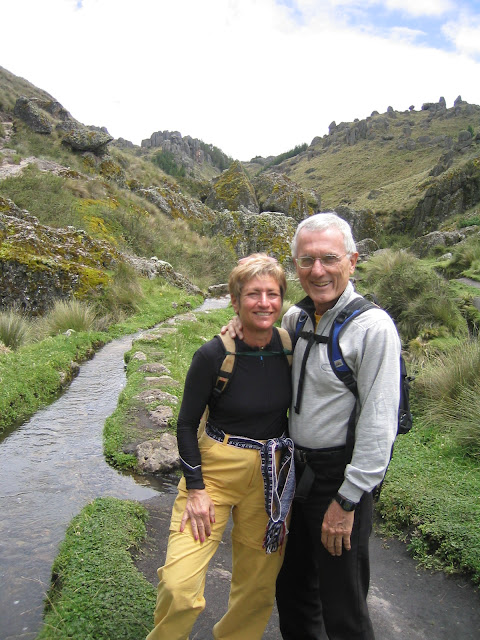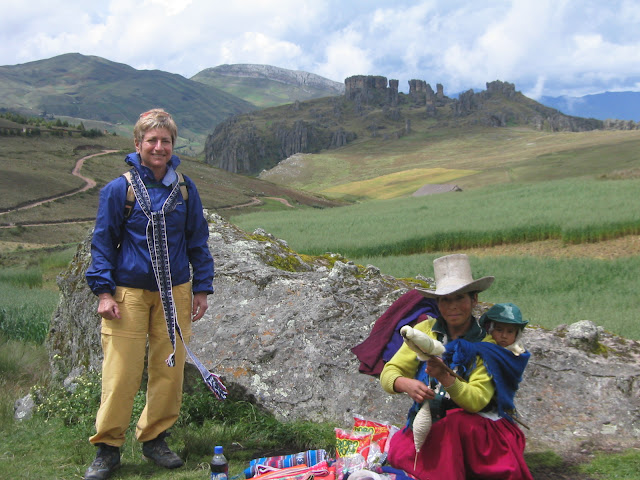However, outside our room, but right in front, was a large round pool with some areas around it covered, some not. There was an attractive piece of pottery with thermal water flowing into the pool from the pottery. We asked for the pool to be made a little hotter and the staff quickly did that through the pottery spout. The hot water gurgled from the pottery into the pool. We were told that most of the guests prefer the pools to be cooler rather than warmer. We like our hot pools to be around 39° C; usually, we have to request that temperature. The soaks we took at Laguna Seca were wonderful, even in the rain.
Soaking in the outdoor pool at Hotel Laguna Seca Baños Termales
We carry with us fluffy terrycloth robes in case the hotel where we stay doesn’t have them (no wonder we have 11 suitcases with us). At Laguna Seca, we used our robes to go to and from our room and to stay warm even in the rain. There was enough covered area around the pool to keep them dry too.
One of the services the hotel provides is free, guided hikes around the area. Euofenia from the hotel took us on a hike to Llacanora and the cascades (13 km from Cajamarca). It was fun but, because of all of the April rain, very muddy. We took a colectivo/minivan for the last bit when our shoes started to sink and stick in the mud. We had seen minivans all over Perú but this was the first time we took one. It was surprisingly comfortable and the cost for us and the guide was US$1.
One of the services the hotel provides is free, guided hikes around the area. Euofenia from the hotel took us on a hike to Llacanora and the cascades (13 km from Cajamarca). It was fun but, because of all of the April rain, very muddy. We took a colectivo/minivan for the last bit when our shoes started to sink and stick in the mud. We had seen minivans all over Perú but this was the first time we took one. It was surprisingly comfortable and the cost for us and the guide was US$1.
Another day we hired a guide, Eleana, to give us a tour of the El Complejo de Belén: a small archeological museum. the church. and the museo de etnografía. We liked Eleana so much we hired her to go with us in our car to the Ventanillas de Otozco and Huanbocancha. It was a lovely tour and we saw the road that goes to the mines where our friends, that work for Newmont and Flour, work. I think I recall that the tour with Eleana for 3 hours cost S/.30 or around US$10.
We checked out Cajamarca for every day “livability” too. Our friends Marnie and Dennis who we met in Santiago de Chile were moving there so that Dennis could work at the mine. We think that Cajamarca would be a fun place to live. It has great tourist infrastructure and it’s culturally extremely interesting.
The highlight of all of our tours around Cajamarca was a tour company’s trip to Cumbe Mayo. The tour company used a minivan that was comfortable enough. Unfortunately, we were the first ones on the bus and it took over one hour for all of the people to be picked up from their hotels. Cumbe Mayo is 20 km southeast of Cajamarca and the road there is unpaved and difficult. It’s good we didn’t drive our car. And, the minivan was fine. Discovered in 1937, this complex is surrounded by the beautiful stone forest silhouettes of pious friars called frailones or giant friars. The aqueduct (1000BC) is a unique work of hydraulic engineering and the petroglyphs from that time were fascinating. (Mega Tours S/.50 or US $15.72 for a tour with 10 people in a van that took 4 hours.)
Our Pentax camera died (the on/off button stopped working just as the repairman in Lima had predicted). Unfortunately, we didn’t have a camera on this trip. But, fortunately, Steve Sayre and Victor Avila from San Francisco were on the tour and they took photos of us with their camera and e-mailed them to us.
The picture of us at Cumbe Mayo that Steve and Vic took
Steve and Victor were on a one-year trip around South America when we met them. Later Steve e-mailed the following to us:
There weren’t too many good restaurants in Cajamarca. One that we did like was Paskana Restaurant, Av. Atahualpa 947, km2, Villa Universitaria, Cajamarca, fono 344 217, cel 9487796 #516012, e-mail: lapaskana@hotmail.com or informes@paskana.com , web: www.paskana.com. Our total bill was S/.101.50 including service.
One night we ate at the Libertador Hotel on the Plaza de Armas. It was good but not worth the ride into town from Baños del Inca.
We loved the people-scape in Cajamarca. The men and women wear distinctive tall hats and colorful clothes and have Inca-looking, mocha-colored faces. In the morning some streets are clogged with local markets. It’s a bonanza for tourists! Before our camera died, we got some great people photos. It gets cold in Cajamarca. The women wear short (usually black) skirts with lots of petticoats to make them flare. Under the skirts, they wear thick wool pantyhose-like things, also usually black. The color in their outfits comes from the shirts and ponchos they wear.
“It took Vic and me about 3 months to fall into a rhythm where we weren't driving each other crazy and had enough independence so as not to feel trapped. By the end of our year of travel, we felt we had figured out how to travel together long-term. It's a very delicate balance that isn't easy to reach, I realize now, nor is it for everybody. I'm sure you consider yourselves to be very lucky to be with someone with whom you can travel like this!”
And indeed we do. We know that for most couples being together 24/7 would be too much. And to do that for years on end wouldn’t be pleasant for them. It works for us and we have thrived on it, growing together and melding. So we continue.
We ate several meals at the Laguna Seca hotel dining room. The food was good; there were several regional dishes on the menu that we tried and liked (cuy/guinea pig, for instance). We even had dinner with Enrique, who was living at Laguna Seca and working at the mines (there were a group of miners living there, actually). It was fun. He is Chilean and his wife decided to stay in Chile rather than coming to Perú with him. Later we received an e-mail that Marnie and Dennis had Enrique to their house for dinner. They too had a delightful evening with him!
And indeed we do. We know that for most couples being together 24/7 would be too much. And to do that for years on end wouldn’t be pleasant for them. It works for us and we have thrived on it, growing together and melding. So we continue.
We ate several meals at the Laguna Seca hotel dining room. The food was good; there were several regional dishes on the menu that we tried and liked (cuy/guinea pig, for instance). We even had dinner with Enrique, who was living at Laguna Seca and working at the mines (there were a group of miners living there, actually). It was fun. He is Chilean and his wife decided to stay in Chile rather than coming to Perú with him. Later we received an e-mail that Marnie and Dennis had Enrique to their house for dinner. They too had a delightful evening with him!
There weren’t too many good restaurants in Cajamarca. One that we did like was Paskana Restaurant, Av. Atahualpa 947, km2, Villa Universitaria, Cajamarca, fono 344 217, cel 9487796 #516012, e-mail: lapaskana@hotmail.com or informes@paskana.com , web: www.paskana.com. Our total bill was S/.101.50 including service.
One night we ate at the Libertador Hotel on the Plaza de Armas. It was good but not worth the ride into town from Baños del Inca.
We loved the people-scape in Cajamarca. The men and women wear distinctive tall hats and colorful clothes and have Inca-looking, mocha-colored faces. In the morning some streets are clogged with local markets. It’s a bonanza for tourists! Before our camera died, we got some great people photos. It gets cold in Cajamarca. The women wear short (usually black) skirts with lots of petticoats to make them flare. Under the skirts, they wear thick wool pantyhose-like things, also usually black. The color in their outfits comes from the shirts and ponchos they wear.
The women preserve the traditional dress in Cajamarca
We were unhappy without a camera but we didn’t want to spend a lot of money to replace our Pentax. We will be going back to the States for a short trip and we’ll be able to buy a new one there, without paying duty and value-added taxes. Dimitri had seen an ad in El Comercio while we were in Lima for a camera for about US$100 at Saga Fallabella. There is a new shopping center in Cajamarca, El Quinde Shopping Plaza, with a Saga Fallabella in it. Because the camera we wanted had not come in yet, we had to order it but it actually arrived before we left Cajamarca! We bought a Samsung A403 digital camera for S/.399 or US $125.47.
Then we started south again in Perú; Cajamarca being our most northern town. We were looking forward to biking in Huarez, farther south, but also in the foothills of the Andes. It was too rainy and muddy in Cajamarca while we were there for biking to be pleasant. The later it is in the year, the drier it is supposed to become. So there was hope for our mountain biking.



No comments:
Post a Comment